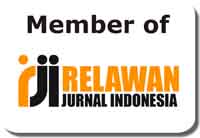Illocutionary Acts in Religious Discourse: The Pragmatics of Nouman Ali Khan’s Speeches
Abstract
Keywords
Full Text:
PDFReferences
Akmal, S. (2017). The Language of Political Campaign in Post-Civil War Muslim Society. ARICIS Proceedings, 1(8), 683–690.
Al-Mansoob, N. T., Patil, K. S., & Alrefaee, Y. (2019). A Cross-cultural Study of The Speech Act of Compliments in American English and Yemeni Arabic. LANGKAWI Journal, 5(1), 1-12.
Andreas, J., & Klein, D. (2016). Reasoning About Pragmatics with Neural Listeners and Speakers. ArXiv. http://arxiv.org/abs/1604.00562
Anggraeni, S. F., & Tajuddin, S. (2018). Expressive Speech Acts And Cultural Values In Collection Of Short Stories Wahah Al-Asdiqa’. El Harakah, 20(1), 99.
Austin, J. (1962). How to do Things with Words. Oxford University Press.
Basra, S., & Thoyyibah, L. (2017). A speech act analysis of teacher talk in an EFL classroom. International Journal of Education, 10(1), 73-81.
Batmang, B. (2018). Question-Answer in ‘Ayat-Ayat Cinta’(A Study of Speech Act in Novel). Langkawi: Journal of The Association for Arabic and English, 4(2), 84-90.
Bergmann, K., Aksu, V., & Kopp, S. (2011). The Relation of Speech and Gestures: Temporal Synchrony Follows Semantic Synchrony. Proceedings of the 2nd Workshop on Gesture and Speech in Interaction (GeSpIn 2011).
Boromisza-Habashi, D. (2012). The cultural foundations of denials of hate speech in Hungarian broadcast talk. Discourse & Communication, 6(1), 3–20.
https://doi.org/10.1177/1750481311427793
Buysse, L. (2012). So as a multifunctional discourse marker in native and learner speech. Journal of Pragmatics, 44(13), 1764–1782.
https://doi.org/10.1016/j.pragma.2012.08.012
Byon, A. S. (2015). Second Language Acquisition. In The Handbook of Korean Linguistics (pp. 389–404). John Wiley & Sons, Inc.
https://doi.org/10.1002/9781118371008.ch22
Carretero, M., Maíz-Arévalo, C., & Martínez, M. Á. (2015). An analysis of expressive speech acts in online task-oriented interaction by university students. Procedia-Social and Behavioral Sciences, 173, 186-190.
Creswell, J. . (2014). Research design, qualitative, quantitative, and mixed methods approaches, fourth edition (4th ed.). Sage Publications.
Danao, A. (2015). Analysing the Aspects of Communicative Competence in the Final Tasks of the Grade 10 English Textbook Using Interactional Participatory Communication Framework. University of Philippines Los Banos.
Egorova, N., Shtyrov, Y., & Pulvermüller, F. (2013). Early and parallel processing of pragmatic and semantic information in speech acts: neurophysiological evidence. Frontiers in Human Neuroscience, 7, 86. https://doi.org/10.3389/fnhum.2013.00086
Ellwanger, A. (2012). Apology as Metanoic Performance: Punitive Rhetoric and Public Speech. Rhetoric Society Quarterly, 42(4), 307–329.
https://doi.org/10.1080/02773945.2012.704118
Fetzer, A., & Bull, P. (2012). Doing leadership in political speech: Semantic processes and pragmatic inferences. Discourse & Society, 23(2), 127–144. https://doi.org/10.1177/0957926511431510
Fitriani, H. N. (2020, August). Teachers’ Directive Speech Acts in Indonesian Learning Interaction in 10th Grade of SMA Bias Yogyakarta. In 1st International Conference on Language, Literature, and Arts Education (ICLLAE 2019) (pp. 245-249). Atlantis Press.
Flanagan, J. L. (2013). Speech Analysis Synthesis and Perception. Springer Berlin Heidelberg. https://doi.org/10.1007/978-3-662-01562-9
Foucart, A., Garcia, X., Ayguasanosa, M., Thierry, G., Martin, C., & Costa, A. (2015). Does the speaker matter? Online processing of semantic and pragmatic information in L2 speech comprehension. Neuropsychologia, 75, 291–303. https://doi.org/10.1016/j.neuropsychologia.2015.06.027
Frey, LR. Botan, C.H. & Kreps, G. L. (2015). Investigating communication: An introduction to research methods. Allyn and Bacon.
Handayani, N. V. (2015). The use of expressive speech acts in hannah montana session 1. Register Journal, 8(1), 99-112.
Hashim, S. S. (2015). Speech Acts in Selected Political Speech. University of Sulaimani.
Holtgraves, T. (2002). Handbook of Communication Competence. The Deutsche Nationalbibliothek.
Hussein, A. L. (2005). A Study of the Speech Acts of Command, Advice and Warning in English Biblical Proverbs and Arabic Proverbs in the Prophetic Traditions. Unpublished PHD. Thesis. University of Baghdad.
Ilyas, S., & Khushi, Q. (2012). Facebook status updates: A speech act analysis. Academic research international, 3(2), 500-507.
Isna, N. & Sari, I. P. (2017). The types of request expressions used in novel “Harry Potter and The Chamber of Secrets”: Their Appropriateness to ESL/EFL Teaching for Junior High School Students in Indonesia. Englisia Journal of Language, Education, and Humanities, 4(2), 99–115.
Johnson, B. & Christensen, L. (2004). Educational Research: Quantitative, Qualitative and Mixed Approaches. Pearson Education, Inc.
Kusumawati, W. (2014). Directive Speech Acts Found In “5CM” Movie. Jurnal Ilmiah Mahasiswa FIB, 5(1).
Lamb, M. (2016). Aquinas and the virtues of hope: Theological and democratic. Journal of Religious Ethics, 44(2), 300-332.
Leech, G. (1996). Principles of Pragmatics. Longman.
Lindsay, G., Dockrell, J., Law, J., & Roulstone, S. (2012). The Better Communication Research Programme: Improving provision for children and young people with speech, language and communication needs. Department for Education.
Mahmud, M. (2017). Communicative styles of English students at the State University of Makassar. GEMA Online® Journal of Language Studies, 17(1).
Martínez Flor, A. (2005). A theoretical review of the speech act of suggesting: Towards a taxonomy for its use in FLT. Revista alicantina de estudios ingleses, No. 18 (Nov. 2005); p. 167-187
May, T. (2011). Social research. McGraw-Hill Education.
Mills, S. (2014). Language and gender: Interdisciplinary perspectives. Routledge.
Nur, D. R. (2016). An Analysis of Derivational Affixes in Commencement speech By Steve Jobs. Script Journal: Journal of Linguistic and English Teaching, 1(1), 25–35. https://doi.org/10.24903/sj.v1i1.18
Pamungkas, B. T., Rustono, R., & Utanto, Y. (2018). The Function of Directive Speech Acts in Gamal Komandoko's Indonesian Archipelago Folklore Text. Journal of Primary Education, 7(2).
Piwek, P. (2007). Modality choice for generation of referring acts: Pointing versus describing.
Purnanto, D., & Tarjana, S. S. (2018). The Realisation of Directive Speech Act by Da’i on Dialogic Da’wah in Kota Surakarta: A Socio-Pragmatic Study. Komunitas: International Journal of Indonesian Society and Culture, 10(1), 14-24
Sahrin, A., & Mahyuni, M. (2020). Codeswitching in Nouman Ali Khan’s Islamic Lectures. Indonesian Journal of Social Sciences and Humanities, 1(1), 31–40.
Searle, J.R. (1999). Mind, Language and society: Philosophy in the real world. Guernsey Press Co.
Searle, J.R. (1969). Speech acts: An essay in the philosophy of language. Cambridge University Press.
Searle, J. R., Kiefer, F., & Bierwisch, M. (Eds.). (1980). Speech act theory and pragmatics (Vol. 10). Dordrecht: D. Reidel.
Tatsuki, D. H., & Houck, N. R. (2010). Pragmatics: Teaching Speech Acts. Teachers of English to Speakers of Other Languages, Inc. 1925 Ballenger Avenue Suite 550, Alexandria, VA 22314.
Tur, G., & De Mori, R. (2011). Spoken language understanding: Systems for extracting semantic information from speech. John Wiley & Sons, Inc.
Ulum, M., Sutopo, D., & Warsono, W. (2018). A Comparison Between Trump’s and Clinton’s Commissive Speech Act in America’s Presidential Campaign Speech. English Education Journal, 8(2), 221-228
Vasaly, A. (2013). The political impact of Cicero’s speeches. In The Cambridge Companion to Cicero (pp. 141–159). Cambridge University Press.
Williams, M., & Moser, T. (2019). The art of coding and thematic exploration in qualitative research. International Management Review, 15(1), 45-55.
Wilson, J. (2015). Talking with the president: The pragmatics of presidential language. Oxford University Press.
Yamada, T. (2007, June). Acts of promising in dynamified deontic logic. In Annual Conference of the Japanese Society for Artificial Intelligence (pp. 95-108). Springer, Berlin, Heidelberg.
Yule, G. (2006). The Study of Language (3rd ed). Cambridge University Press.
DOI: http://dx.doi.org/10.31332/lkw.v6i2.1938
Copyright (c) 2020 Saiful Akmal

This work is licensed under a Creative Commons Attribution-ShareAlike 4.0 International License.
Langkawi: Journal of The Association for Arabic and English indexed by:


















.png)
.png)

.png)
2.png)








